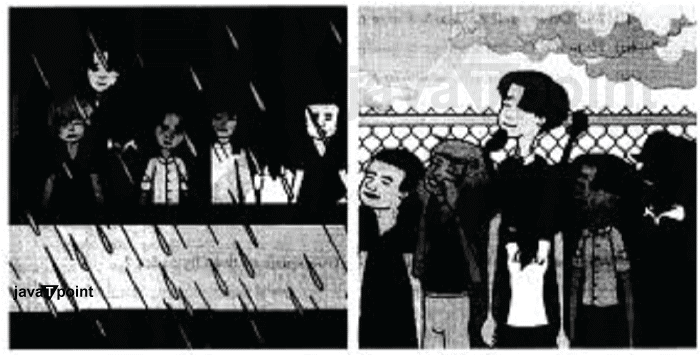All Summer in a Day SummaryIntroductionThe science fiction short tale "All Summer in a Day" was written by Ray Bradbury. It was initially released in 1954's issue of The Magazine of Fantasy and Science Fiction, and since then, it has grown to be one of Bradbury's most well-known and appreciated works. The action occurs on Venus, where it continually rains except for an hour every seven years when the sun shines. Except for one girl who just relocated to Venus from Earth and has never seen the sun, the other students in the novel are excitedly anticipating this unusual occasion. The plot examines envy, bullying, and people's longing for things they can't have. It has been turned into a stage play, a short film, and a radio drama. 
Characters and the SettingSettingThe story is set on Venus, where it always rains, and the sun only shines for an hour every seven years. Future humanity had colonized Venus and constructed underground dwellings to shield themselves from the hostile atmosphere when the novel is set. Characters1. Margot Margot is a nine-year-old girl who just relocated from Earth to Venus. She yearns to see the light because she recalls it. 2. William A boy teases Margot and encourages the other kids to keep her out of their games. 3. The Other Children The other kids are many school kids excitedly awaiting Venus's rare solar eclipse. 4. The Teacher The teacher is a woman who makes an effort to instruct and discipline the kids but eventually fails to stop them from abusing Margot. SummarySummary of the Plot "All Summer in a Day" is a short story about a group of kids who live on Venus, a planet where the sun only shines for an hour every seven years and always rains. Except for one girl, Margot, the other youngsters eagerly anticipate the sun's unusual appearance at the novel's start. Margot knows the sun from her time on Earth and longs to see it again. Margot's classmates, led by a kid named William, abuse and isolate her because they envy their teacher's praise for her distinctive viewpoint. The kids get increasingly excited as the hour of sunshine draws near, while Margot gets increasingly agitated and frantic to see the sun. As the sun rises, the kids lock her in a closet and rush outside to enjoy the warmth and light. 
The children return to their underground dwellings once the hour has passed as the rain resumes, but they quickly notice that Margot is still imprisoned in the closet. They release her and feel bad about what they did, but the opportunity has passed, and they won't see the sun for another seven years. On the other hand, Margot is left to deal with her feelings of loneliness and desire after missing her only opportunity to view the sun. The narrative closes with a depressing tone, implying that Margot's loneliness and her classmates' harshness will persist. Messages and ThemesJealousyThe story explores jealousy because Margot's classmates envy her rare opportunity to witness the sun rising on Earth. Because of the bullying and rejection this jealousy brings, Margot is eventually kept in a closet during the rare window of sunshine. Powerlessness
The impotence issue is also brought up in the novel because Margot's teacher is helpless to stop the bullying and abuse she witnesses. Despite her best attempts, the kids are ultimately motivated by their desires and feelings. Human YearningThe narrative investigates human yearning for impossibilities. While Margot longs for the sun she remembers from her time on Earth, the children yearn for the sun, which only shines for an hour once every seven years. As the anecdote demonstrates, this desire can result in happy and negative feelings. IsolationSince only Margot remembers the sun and longs to see it again, isolation is another motif in the novel. She must deal with her loneliness and longing when her peers reject her. Group MentalityThe narrative also points to the perils of group mentality, as the kids lose their empathy for Margot in the thrill of the sun's coming. They lock her in a closet without thinking about the repercussions of their actions. Images and SymbolismSunThe sun is a strong metaphor for warmth, light, and hope throughout the narrative. For the characters, it is a unique and treasured event, and thinking back on it makes them feel nostalgic and longing. RainRain is the story's most prominent visual representation of Venus's harsh and miserable climate. The characters are confined by it, unable to leave their underground homes or see the outside world because it is always present. Margot's Yellow DressMargot's yellow dress serves as a visual representation of her distinction from the other kids. In contrast to the subdued hues of the other characters' attire, it is a bright and cheery colour. It also symbolises her bond with the sun and desires to see it. The ClosetThe closet where the other kids keep Margot during the hour of sunshine represents the brutality and marginalisation she endures at their hands. It's cramped size and gloomy atmosphere stand in for her helplessness and helplessness. TearsThe novel frequently depicts tears as a symbol of the character's emotional reactions to the unusual experience of seeing the sun. When Margot realises, she has missed her chance to see the sun, she sobs, and the other kids sob in remorse for treating her badly. Tears symbolise the characters' mixed emotions, including joy, grief, and other strong feelings. Literary Devices UsedImageryThe novel uses sensory language to vividly depict the terrible rain and the sun's seldom arrival. SymbolismThe story employs symbolism to illustrate its themes and takeaways. Several symbols have a deeper meaning, including the sun, rain, yellow dress, wardrobe, and tears. ForeshadowingThe novel makes an early allusion to the prospect that Margot would be treated unfairly by her classmates, setting up the conflict that propels the plot. IronyBecause Margot is the only character in the novel who genuinely understands the significance of the sun's unusual appearance, the characters' delight in it causes them to mistreat and exclude Margot. AllusionThe narrative alludes to William Shakespeare's play Macbeth, in which a famous line is uttered by a character: "Tomorrow, and tomorrow, and tomorrow, creeps in this petty pace from day to day." The statement is used in the story to illustrate the kids frustration and boredom. Review of the NarrativeThe story "All Summer in a Day" examines the concepts of jealousy, loneliness, and helplessness. Venus's perpetual rain and few sunbursts produce a gloomy, dismal mood highlighting the protagonists' desperate search for more. Margot stands for both the beauty and the cruelty of diversity since she is the outsider who recalls the sun from her time on Earth. She is shunned by her classmates, who envy her experience and lock her in a closet during the brief window of sunshine. The severity of their deeds produces a sense of sorrow and loss in contrast to the wonder and joy that the sun gives. The narrative also points out the perils of having a group mentality and the strength of peer pressure. The kids' delight in the sun's emergence causes them to lose sight of Margot's plight. They act without thinking about the repercussions, which causes a moment of shared regret and remorse. The story effectively conveys its ideas and messages through imagery and symbolism. Margot's yellow clothing and the closet are striking images of her distinctiveness and isolation, yet the sun and rain are potent emblems of oppression and hope, respectively. The story is both eerie and unforgettable because of the author's use of sensory language and vivid images to evoke powerful emotions. "All Summer in a Day" is a compelling human experience and emotional examination. It is a masterpiece of the short tale form because of its universal and ageless themes of resentment, solitude, and helplessness. Analogies with Other Works"All Summer in a Day" has elements in common with previous literary works that tackle the subjects of exclusion and repression. One such book is George Orwell's "1984," which takes place in a dystopian society where the government stifles individuality. The protagonists in "1984" experience relative isolation and repression while being forced to submit to a totalitarian government that cracks down on dissent. Both tales reference the perils of groupthink and the value of individuality. "The Yellow Wallpaper" by Charlotte Perkins Gilman is another similar piece. The narrator of this short story is locked in a room by her spouse and slowly lapses into insanity. Like Margot in "All Summer in a Day," the narrator feels alone and left out, making them feel helpless and hopeless. The novel "Fahrenheit 451" by Ray Bradbury likewise examines themes of injustice and solitude. The protagonist of the narrative, a fireman whose job is to burn books, lives in a society where reading is outlawed. The protagonists in "Fahrenheit 451" experience similar oppression and isolation as they are compelled to fit in with a culture that stifles original thought and innovation. Through the protagonist's experiences, the themes of exclusion and oppression are explored in all of these works. The fundamental message?that the repression of individuality and free thought results in helplessness and despair?remains the same regardless of the places and storylines. 
Cultural and Historical ContextUnderstanding the themes and ideas of "All Summer in a Day" requires knowledge of its historical and cultural setting. In general, the historical and cultural background of "All Summer in a Day" sheds light on the themes and ideas of the novel. The story's characters and surroundings were moulded by Cold War worries and social pressures to fit in, reflecting its period and a commentary on the human condition. Reviewers' Reactions and LegacySince its release in 1954, "All Summer in a Day" has gotten positive reviews from critics. The narrative has received attention for examining issues including loneliness, repression, and the value of individuality. Ray Bradbury's use of strong symbolism and vivid imagery, as well as his aptitude for building tension and suspense throughout the novel, have also received recognition. The tale is frequently taught in schools and universities as an example of potent short fiction because it has been published in numerous science fiction and literary anthologies. Additional adaptations include a theatrical play and a short film. "All Summer in a Day" has left a literary legacy and an impression on popular culture. The tale is still popular with readers and viewers and has been referred to and hinted at in numerous films, television series, and songs. Overall, "All Summer in a Day" is still regarded as a highly esteemed literature and science fiction piece. It is a vital addition to the canon of literature because its themes and messages are still relevant to readers and offer an understanding of the human condition. Background and Writing Style of the AuthorAmerican author Ray Bradbury, who wrote "All Summer in a Day," was born in 1920. He was well-known for his original work and contributions to the science fiction genre. He was well-known for his contributions to science fiction and distinctive literary style, frequently blending social commentary, fantasy, and horror. In the 1940s, Bradbury started writing professionally, and during his career, he published many novels, short stories, and essays. His short story collections, such as "The Illustrated Man" and "The Martian Chronicles," were particularly well-known. Strong symbolism, poetic language, and vivid imagery distinguished Bradbury's writing style. The power of imagination and invention, the perils of conformity, and uniqueness were all common themes in his works. In "All Summer in a Day," Bradbury employs his distinctive writing technique to infuse the entire book with tension and suspense. His use of imagery, especially the recurrent depictions of rain and sunlight, contributes to creating the story's atmosphere and supports its central themes of oppression, isolation, and the value of uniqueness. Overall, "All Summer in a Day" has become a well-known and lauded piece of science fiction and literature thanks to Bradbury's distinctive writing style and capacity to produce potent imagery and symbolism.
Next TopicArms and the Man Summary
|
 For Videos Join Our Youtube Channel: Join Now
For Videos Join Our Youtube Channel: Join Now
Feedback
- Send your Feedback to [email protected]
Help Others, Please Share









